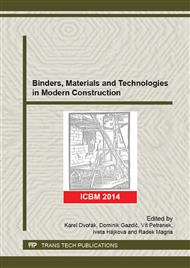[1]
Kolář, K.: Durability of building materials and structures. In 6. konference Speciální betony. Degradace - Destrukce - Recyklace. Praha: Sekurkon, 2009, s. 6-30.
Google Scholar
[2]
Claisse, P. A., Transport properties of concrete: Measurement and applications, 1 st ed., Woodhead Publishing, (2014).
Google Scholar
[3]
Basheer, L., Kroop, J., Cleland, D.J. Assessment of the durability of concrete from its permeation properties: a review. Construction and Building Materials, Vol. 15, 2001, pp.93-103. DOI: 10. 1016/S0950-0618(00)00058-1.
DOI: 10.1016/s0950-0618(00)00058-1
Google Scholar
[4]
Reiterman, P., Increasing oft he durability of concrete cover, in: P. Polach, L. Stuna (Eds. ), Proceedings of the 52th International Conference on Experimental Stress Analysis (EAN 2014), Vyzkumný a zkusebni ustav Plzeň, Plzeň, 2014, ISBN 978-80-231-0377-6. DOI: 2-s2. 0-84906278703.
Google Scholar
[5]
Polozhiy, K., Keppert, M., Jogl, M., Cerny, R., 2014, Mechanical behavior of the cement mortar with high amount of municipal solid waste incineration (MSWI) bottom ash as an alternative aggregate, Advanced Materials Research, Vol. 982, pp.74-78.
DOI: 10.4028/www.scientific.net/amr.982.74
Google Scholar
[6]
Jaskulski, R., Kubissa,W., 2014, Mechanical properties and resistance to water ingress of cement concrete made with non-cyclic alkanes, Advanced Materials Research, Vol. 1054, pp.58-63. DOI: 10. 4028/www. scientific. net/AMR. 1054. 58.
DOI: 10.4028/www.scientific.net/amr.1054.58
Google Scholar
[7]
Čáchová, M., Koňáková, D., Vejmelková, E., Keppert, M., Polozhyi, K., Černý, R., 2014, Pore structure and thermal characteristics of clay bricks, Advanced Materials Research, Vol. 892, pp.104-107. DOI: 10. 4028/www. scientific. net/AMR. 982. 104.
DOI: 10.4028/www.scientific.net/amr.982.104
Google Scholar
[8]
Fridrichová, M., Dvořák, K. Gazdič, D., Alpha plaster produced by the pressureless method of dehydration in salt solution, Ceramics-Silikáty, 2014, 58(1), pp.21-27. ISSN 0862-5468. DOI: 2-s2. 0-84902839897.
Google Scholar
[9]
Cachová, M., Konakova, D., Vejmelkova, E., Reiterman, P., Keppert, M., Cerny, R., 2014, Properties of lime plasters with different ceramic powder dosage, Applied Mechanics and Materials, Vol. 621, pp.19-23.
DOI: 10.4028/www.scientific.net/amm.621.19
Google Scholar
[10]
Vejmelková, E., Keppert, M., Reiterman, P., Černý, R., Mechanical, hygric and thermal properties of building stones, Proceedings of 13th International Conference on Structural Repairs and Maintenance of Heritage Architecture, STREMAH 2013; New Forest; United Kingdom; 25 June 2013 through 27 June 2013; Code 100857, Vol. 621, pp.357-367.
DOI: 10.2495/str130301
Google Scholar
[11]
Holcapek, O., Litos, J., Zatloukal, J., 2014, Destructive and nondestructive characteristics of old concrete, Advanced Materials Research, Vol. 1054, pp.243-247. DOI: 10. 4028/www. scientific. net/AMR. 1054. 243.
DOI: 10.4028/www.scientific.net/amr.1054.243
Google Scholar


